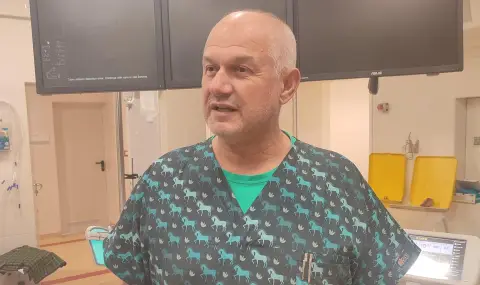An innovation for the treatment of a diabetic foot with the patient's own tissue and artificial intelligence was implemented at UMBAL Burgas. Personalized skin regeneration uses the body's natural defenses. Its most serious application is in the so-called diabetic foot, but is also an option for other difficult-to-heal wounds. More than half of leg amputations in Bulgaria are due to the diabetic foot, and the new technology gives patients a chance to keep their legs. So far, the method has been implemented on a pilot basis in three cities in our country. In front of FACTS, Prof. Dr. Valentin Vassilev, head of the Clinic for Vascular Surgery at UMBAL Burgas.
- Prof. Vassilev, it is clear that medicine is developing at a very fast pace, but tell us about the innovation that you apply to treat diabetic foot?
- This was a demonstration of a new method that we got acquainted with at one of the last scientific forums. It was invented in South Korea, which, as we know, is a leading country in high-tech developments, including in medicine. Simply explained – it is an artificial intelligence that, using a tablet with a built-in application, captures the wound and makes a kind of “passport“ – size, dimensions. Fat tissue is taken from the patient through liposuction. This tissue along with other biocompatible ingredients – the so-called tissue glue is placed in a 3D printer. The printer uses the app's calculations and prints an individual patch based on the dimensions of the wound. The patch is placed in the wound and helps to regenerate the tissue faster. What is unique about this case is that this skin insert uses the patient's own cells, his own regenerative powers.
- How complicated is it as an operative intervention?
- The intervention is not complicated, it is relatively quick, and the patient is conscious, partially anesthetized. It took us longer than necessary because we were performing it for the first time, we had an explanation of each of the stages, and we had students in the Clinic observing the process. We are a University Hospital, we train specialists, students, it is important that young doctors have access to the latest innovations in science. With routine application, it takes up to an hour, an hour and a half.
- Where and how were our doctors trained?
- For the first time we saw the application of the method at the XXVIII National Annual Conference of the Bulgarian Society of Vascular and Endovascular Surgery. After that, we invited the representative company to our Clinic for Vascular and Endovascular Surgery at UMBAL Burgas for a presentation. The application is not complicated at all, nothing different from our usual work in wound care, no long training is required.
- This is a completely new approach to the treatment of severe chronic wounds. In what cases can it be used?
- The most serious application is in the treatment of diabetic foot, which is a great scourge for diabetics. More than half of leg amputations in Bulgaria are due to this diagnosis. It is a direct consequence of the metabolic syndrome and the development of diabetes mellitus. Diabetic foot is atherosclerosis, a short-term vascular-degenerative syndrome of the vessels of the lower extremities and is a narrowing and blockage of the blood vessels of the feet and lower legs. This leads to a feeling of coldness, limping also occurs. Neuropathic diabetic foot is a consequence of peripheral nerve damage (so-called diabetic polyneuropathy). It has reduced innervation (sensitivity) of the feet, the patient does not feel injuries on the feet, and if small wounds remain unnoticed, they can become infected. Due to a decrease in local immunity due to diabetes, the feet have deformations, which leads to the development of a fungal infection. It, in turn, is a gateway for bacterial infection, and then the so-called diabetic gangrene, which is already extremely dangerous, as it can lead to amputation of a limb.
- The system was developed by a South Korean company, and Bulgaria is the fourth European country to start applying this technology. Which countries are ahead of us?
- South Korea, where the method was invented, USA, Turkey. From the European countries – Italy, Spain, Croatia.
- The device has been on the market for only three months and has not yet been purchased by any medical facility in our country. Is it very expensive?
- A very difficult question, because with the chronic underfunding of clinical pathways and the huge social function that public hospitals like ours take on for the treatment of severe and complicated cases, often of socially weak patients, yes – it is expensive because there are other priorities, other important devices that need to be purchased. This procedure is new, it is not covered by the Health Insurance Fund, this means that patients have to pay extra, and not everyone has the opportunity. From another point of view – it's an investment that pays off over time because amputations cost our health and social care system millions – from sick leave, money for TELC, missed opportunities for these people to work, not to mention the burden on the patient and his family personally. If the Health Insurance Fund pays even partially for such a procedure, a lot of money can be saved to the public health funds, which can be redirected to other activities.
